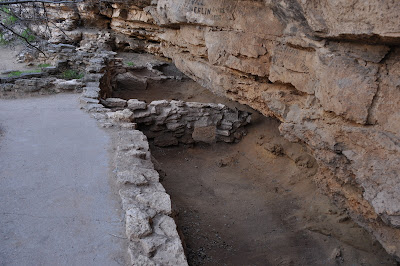Montezuma Well was naturally formed 11,000 years ago when a limestone cavern collapsed into a sunken pool. 12 million years prior the area was covered by a lake 27 by 15 miles. 2 million years ago Lake Verde broke throught the sediment dam, water flowed from the valley and now the Verde River is all that remains.
The caverns, including the one that would become Montezuma Well, were formed by underground streams dissolving the soft limestone.
Note the cliff dwellings left and center.
Here, on the opposite side they also built cave homes.
This is the swallet, the opening through which the stream disappears underground. The water travels 150 ft underground then emerges in an outlet which the prehistoric farmers channeled into a canal to irrigate their crops.
This is the outlet for the stream. Local Hopi continue to use these waters that they believe to be sacred. They come in the morning prior to the opening of the monument or in the evening after closing and collect water at this site for bathing a new baby. This connects the new life with the past.
The largest Arizona Sycamore in the state.
This canal was three feet deep and was used for irrigation purposes. The flow continues to the Verde River.
Pit house floor - all that remains of the original structure. The original entrance area is on the right. Wall posts rotted away long ago but the holes where they stood remain around the perimeter. The larger holes in the center held the roof supports. Now the floor is covered and enclosed to protect it from the elements.
Montezuma Castle - once a five-story, 20-room dwelling. The castle was occupied from the early 1100s until, like other residents of the time frame, the early 1400s when they abandoned their pueblos.
The castle stands in a cliff recess 100 feet above the valley.
Castle A, built at the base of the cliff, is badly deteriorated. It was once a 6-story apartment-like structure with approximately 45 rooms.
Vic spotted a honeycomb in one of the large openings.














No comments:
Post a Comment